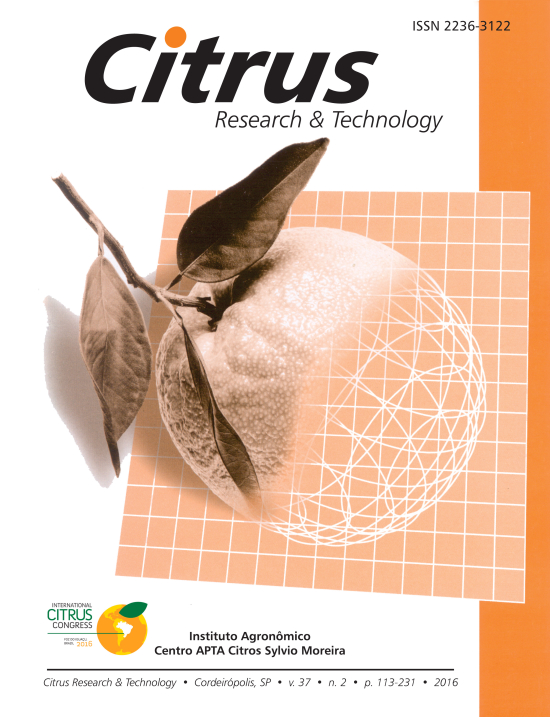Uso de ortofenilfenol para o controle pós-colheita da podridão peduncular em lima ácida 'Tahiti'
Use of orthophenilphenol for the postharvest control of stem rot in 'Tahiti' lime
Lenice Magali do Nascimento, Katia Cristina Kupper & Eduardo José dos Santos
Resumo
O presente trabalho teve por objetivo averiguar a eficiência de tiabendazol, detergente neutro, ortofenilfenato de sódio (SOPP) e ortofenilfenol (OPP a 13%) no controle pós-colheita de Phomopsis citri em lima ácida ‘Tahiti’. Realizaram-se dois experimentos, um com inoculação do patógeno e outro sem, considerando a infecção oriunda do campo. Repetiram-se ambos os experimentos, três vezes. Realizou-se a inoculação dos frutos mediante duas perfurações de 2 mm na região mediana e oposta da casca. Inocularam-se os esporos de P. citri, cultivado in vitro, por meio de raspagem da colônia, usando palitos autoclavados. Após uma hora da inoculação do patógeno, aplicaram-se 10 µL, das diferentes doses dos seguintes produtos: tiabendazol, detergente neutro, OPP, detergente neutro + OPP, SOPP e água (testemunha) nas mesmas perfurações dos frutos. Acondicionaram-se estes, em seguida, em caixas plásticas, mantendo-os a 10ºC e 90% U.R. ou sob condição ambiente. A partir do início do desenvolvimento dos sintomas, efetuaram-se medições diárias do tamanho das lesões, utilizando-se paquímetro digital e considerando a região do pedúnculo para o ápice. No segundo experimento, sem inoculação, imergiram-se os frutos durante 2 min, em uma solução dos diferentes produtos. Os resultados obtidos mostraram que aqueles à base de ortofenilfenol foram eficazes no controle pós-colheita de P. citri em lima ácida ‘Tahiti’ e que o tiabendazol não apresentou eficiência no controle do patógeno em estudo.
Palavras-chave
Abstract
This work aimed to study the efficiency of orthophenilphenol (OPP) on the postharvest control of Phomopsis citri in ‘Tahiti’ lime. Two assays were carried out: artificial inoculation of pathogen spore and field infection (i.e., natural pathogen inoculation). The data presented here are the average of experiments. Spores of P. citri were grown in vitro and used for the inoculations, which were done by 2-mm-deep punctures, using sterile toothpicks, in the middle of the fruit in two opposite areas. One hour after the inoculation, 10 µL of different concentrations of thiabendazol, neutral detergent, OPP, neutral detergent + OPP, SOPP (sodium orthophenilphenol) and water (control) were placed into the fruits punctures. Then, all fruits were placed in plastic boxes and stored under refrigeration (10ºC and 90% RH) or at room conditions. After the appearance of the symptoms, the lesions were evaluated by daily measures of the distance between the pedicel and fruit apex using a digital caliper. For the second assay, the non-inoculated fruits were immersed during 2 min in a solution with the same products. The compounds with OPP were efficient on postharvest control of P. citri in ‘Tahiti’ lime, unlike thiabendazol, which was unable to control the pathogen.

